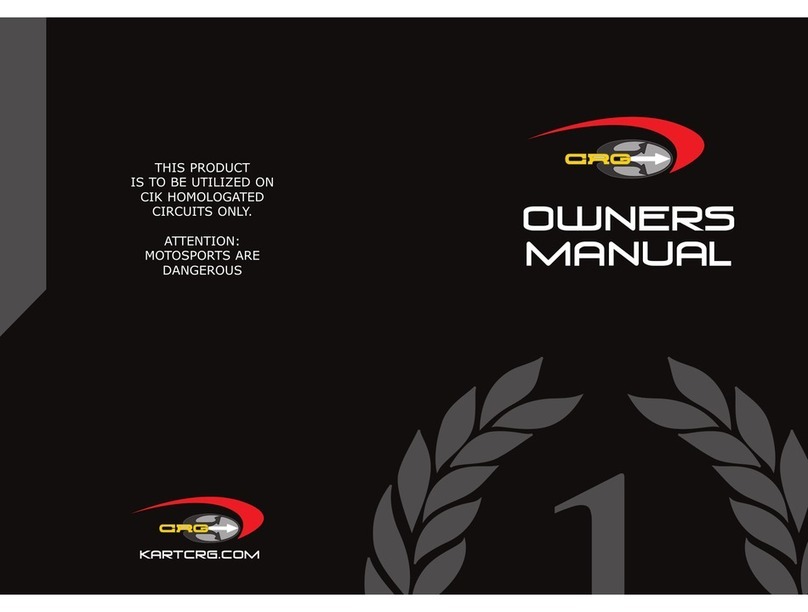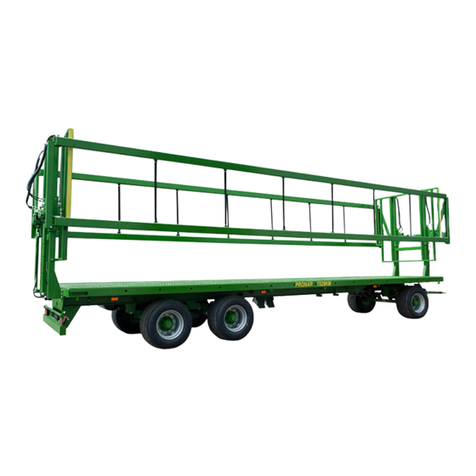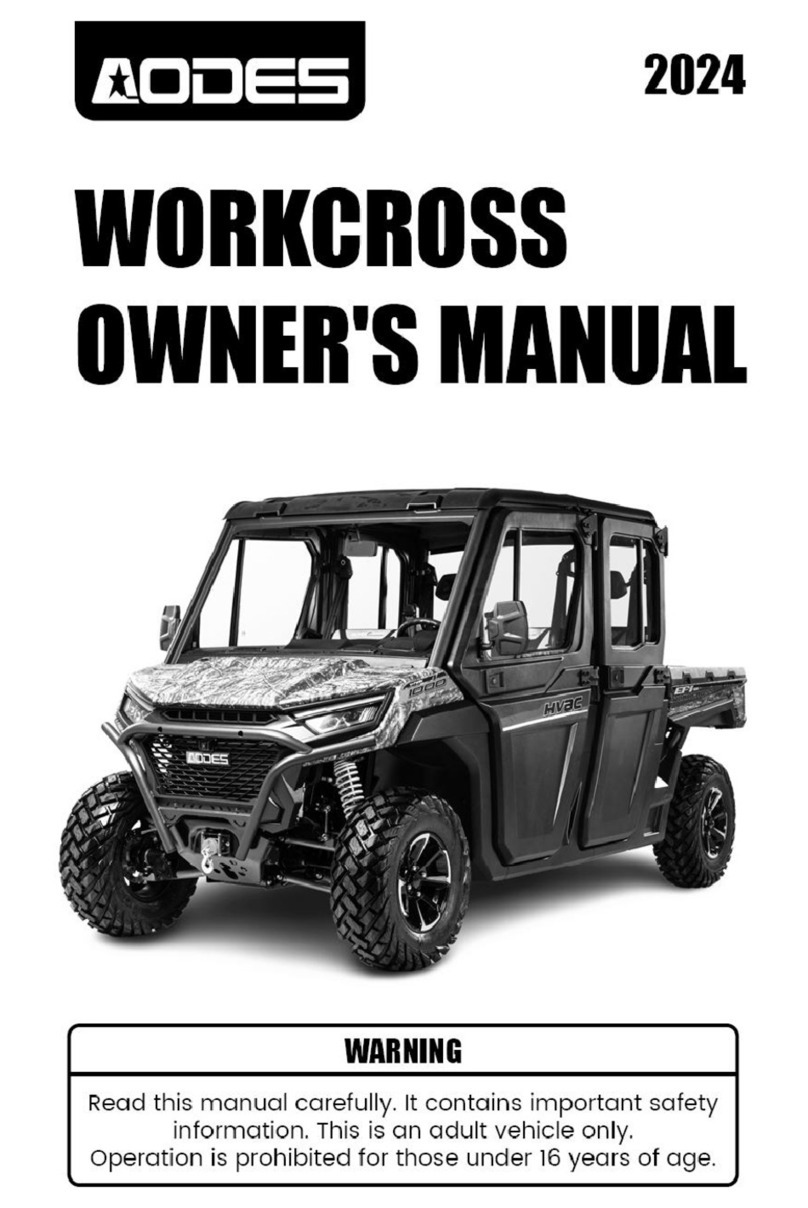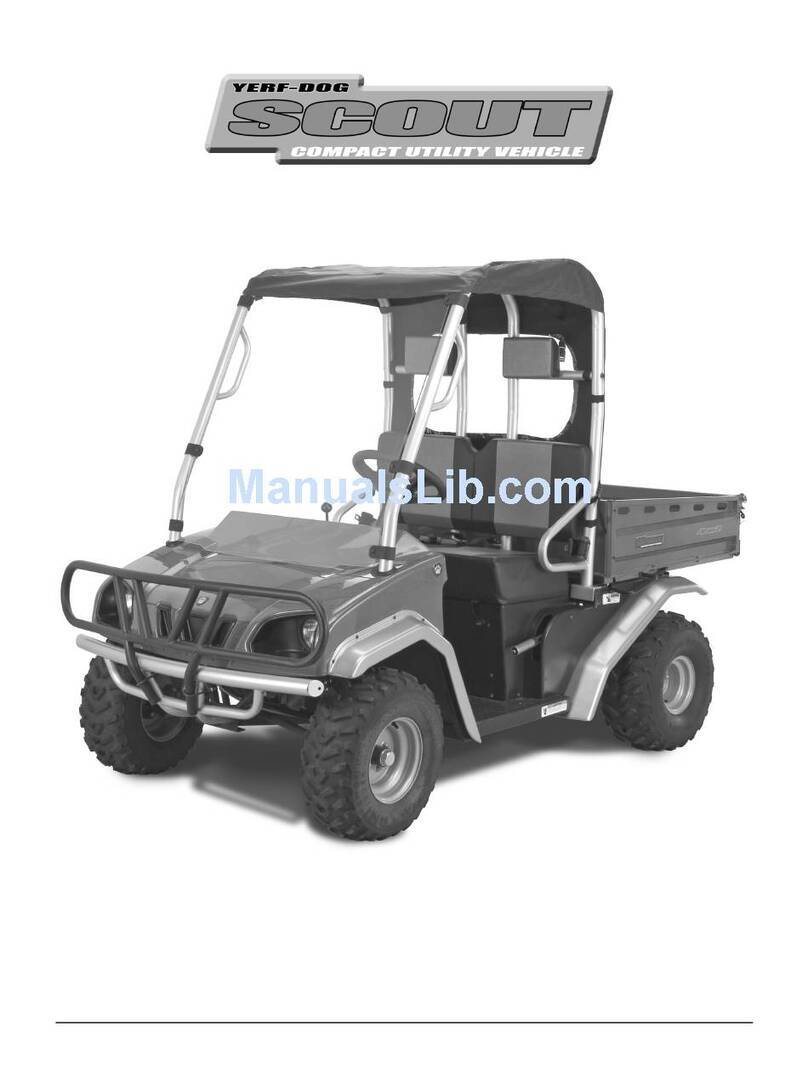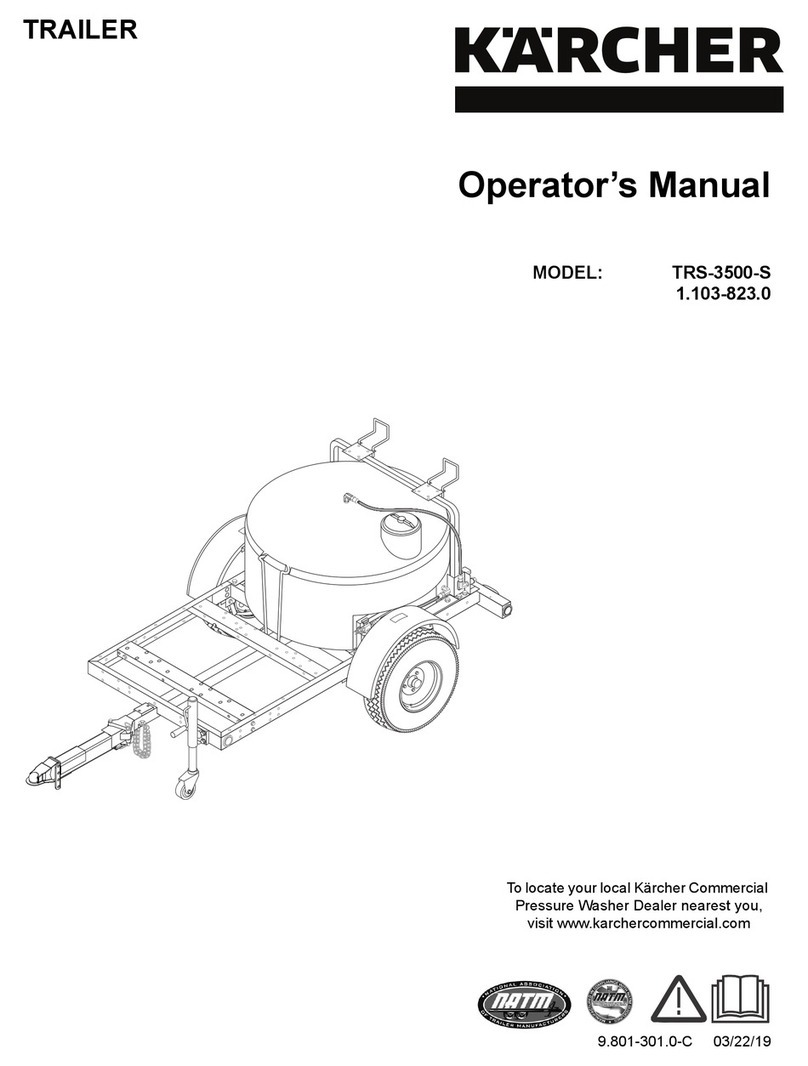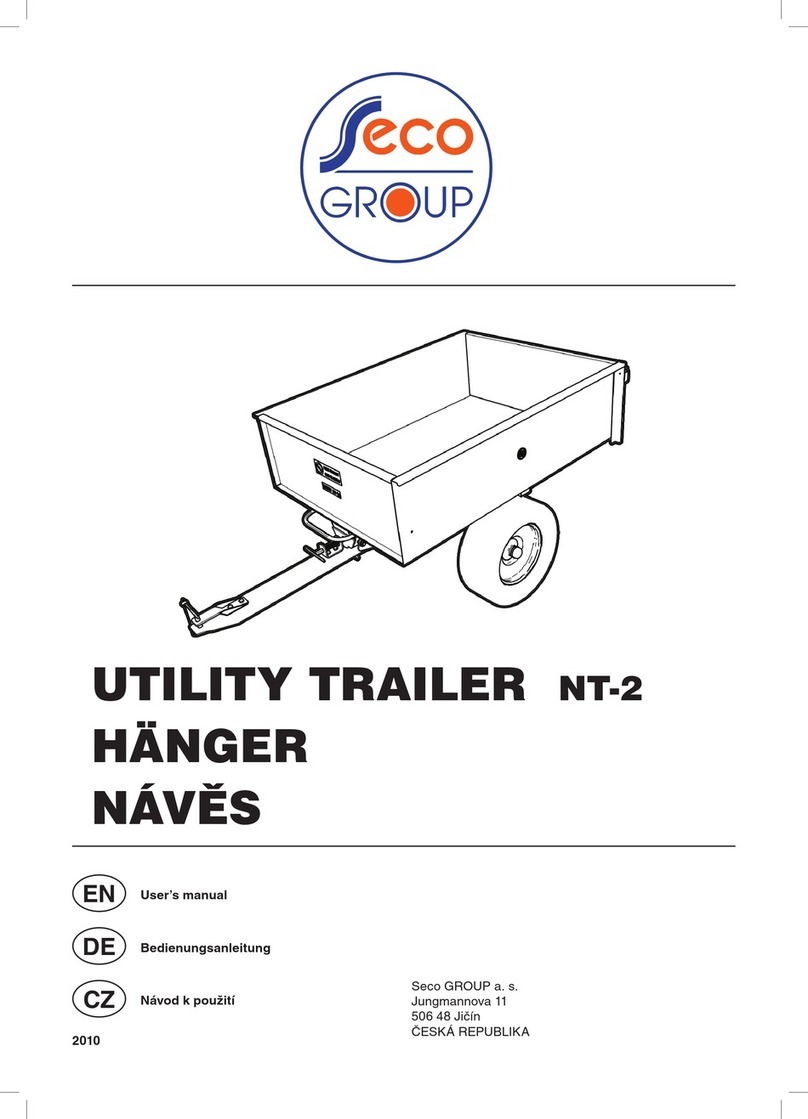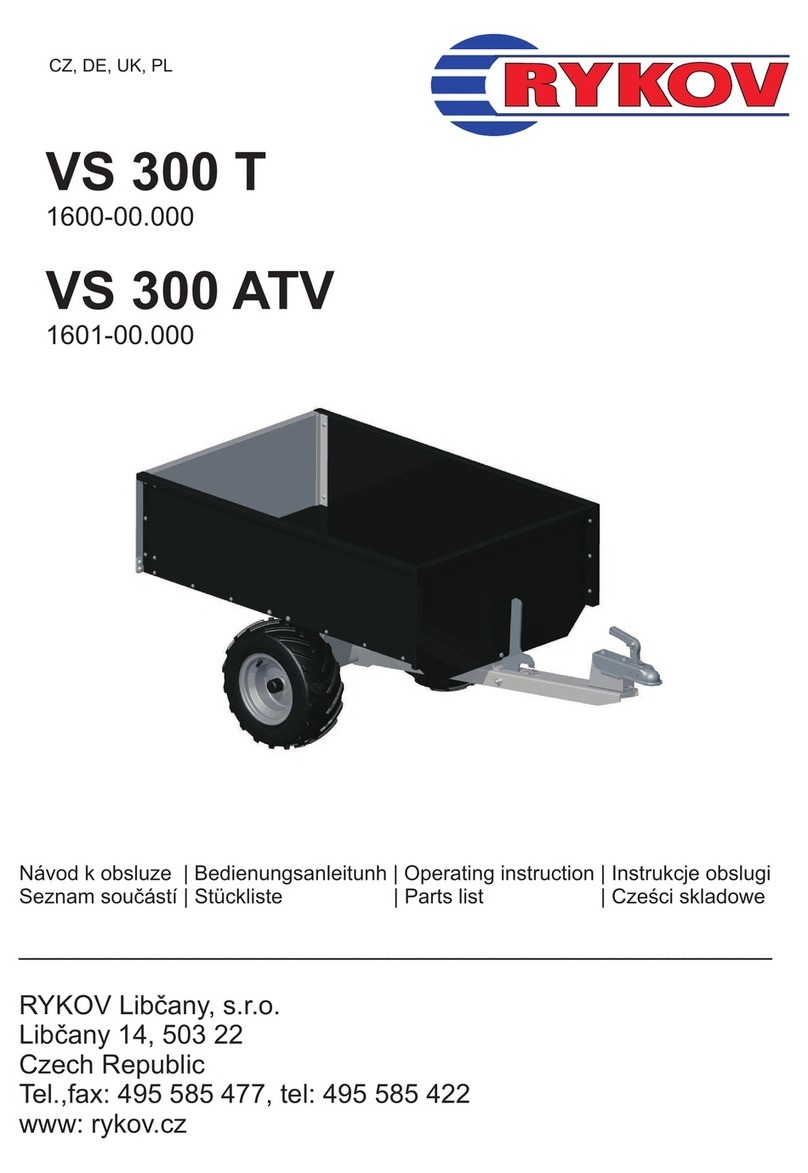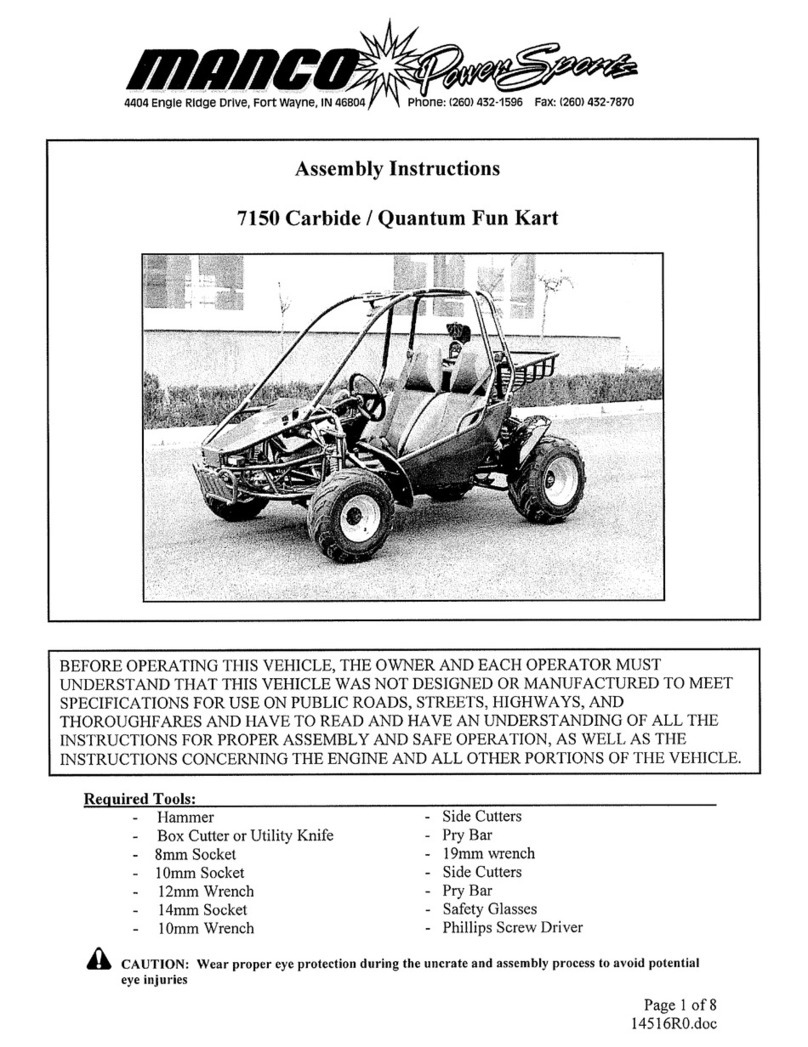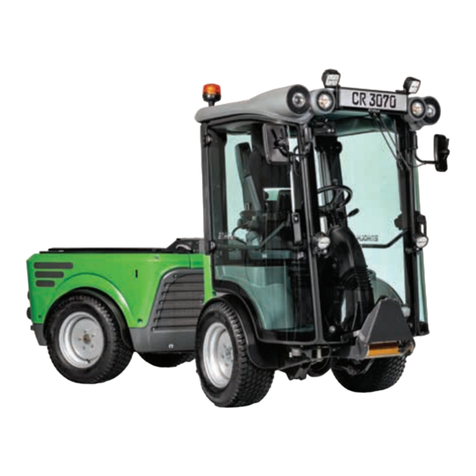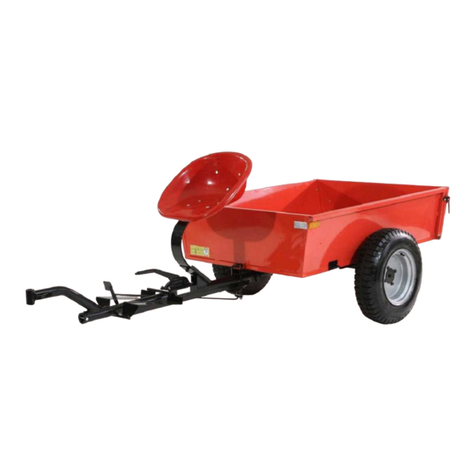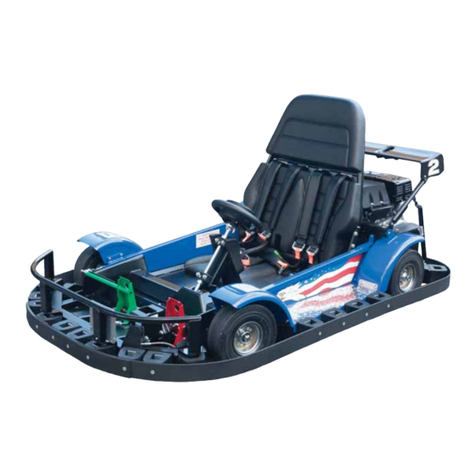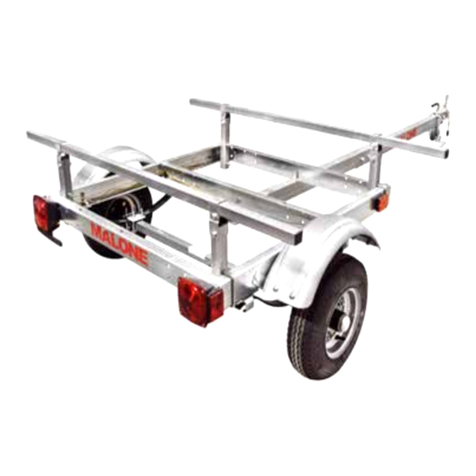CRG CENTURION Series User manual

1
www.crgrentalkart.com www.crgrentalkart.com

Declaration of Conformity
1. Introduction to the Company
Preliminary Information
Manual contents and recipient
Collaboration with the end user
Regulatory compliance
Liability
Client obligation
Extra note
1.0. General instructions
1.1. Intended use of the kart and place of application
1.2. Operating environment of the kart
1.2.1. Information about the track
1.2.2. Adequacy of the track
1.2.3. Age limits and driver training requirements
1.2.4.Driverbrieng
1.2.5. Training of the facility’s staff personnel
1.2.6. Protective equipment
1.3. Safety instructions
1.4. Things to check for before each session
1.5. Maintenance
1.5.1. General maintenance plan
1.5.2. Maintenance: data logging control sheet
1.6. Waste management and disposal
1.7. Chassis maintenance
2.0. Engine
2.1. Transmission oil case
3.0. Fuel supply
3.1. Belt drive transmission
3.2. Chain drive transmission
4.0. Starting the kart
4.1. First start
2
www.crgrentalkart.com www.crgrentalkart.com
pag.4
pag.5
pag.6
pag.7
pag.7
pag.7
pag.8
pag.8
pag.8
pag.8-12
pag.8
pag.8
pag.9
pag.9
pag.9
pag.9
pag.10
pag.10
pag.11
pag.11
pag.12
pag.12
pag.12
pag.12
pag.14
pag.14
pag.14
pag.15
pag.15
pag.15
pag.16
pag.16
INDEX

4.2. Starting the kart without the driver
5.0. Brakes
6.0. Steering system assembly
6.1. Tire pressure
7.0. Bleeding brakes
7.1. Replacing the brake pads
8.0. Pedals
8.1. Replacing acceleration cable
9.0. Front wheel alignment
9.1. Measurement of the hub on the rear axle
9.2. Adjusting the drive belt tension
9.3. Adjusting the chain tension
9.4. Tire change
10.0. Bodywork
10.1. Fixing bodywork
11.0. Mounting of the bodywork and protection
11.1. Left side protection
11.2. Right side protection
11.3. Front bumper
11.4. Rear protection
11.5. Nassau panel
11.6. Spoiler
11.7. Side fairing left
11.8. Side fairing right
11.9. Rear fairing
12.0. Checklist
13.0. Checklist for rst time usage
14.0. Cleaning the chassis
14.1. Problem solving
pag.16
pag.17
pag.18
pag.18
pag.19
pag.20
pag.21
pag.22
pag.23
pag.24
pag.24
pag.25
pag.25
pag.26
pag.26
pag.27
pag.27
pag.27
pag.28
pag.28
pag.29
pag.29
pag.30
pag.30
pag.30
pag.31
pag.31
pag.33
pag.33
3
www.crgrentalkart.com www.crgrentalkart.com

4
www.crgrentalkart.com www.crgrentalkart.com
Dear Partner,
Welcome to our family, your business is now an important member of a winning tradition and a
brand which is considered an institution having won more world titles and produced more formula
talent than any other manufacturer.
You have chosen a product of absolute value, currently the only rental kart brand in the world to
haveattainedtheinternationalsafetynormativespecicallydevelopedforrentalkartsUNIEN
16230-1 : 2013.
We trust our Centurion kart will offer your business added value, making your clients feel the
adrenaline of a high performance racing kart, while at the same time
providing a robust, durable and premium quality product synonymous to CRG.
On behalf of our founder and president Mr. Giancarlo Tinini we thank you and hope to have the
pleasure of your loyal partnership in the many years to come.
For further information please contact our Rent To Race rental kart department in offering you
precise and friendly advice.
Respectfully.
DECLARATION OF CONFORMITY
The manufacturer C.R.G. S.p.A.
Via Mantova, 4F/G 25017 Lonato del Garda (BS) Italia
declares that the vehicle
Denomination:
Rental kart Type B
Function:
Kart designed and constructed for rental use
Model:
CENTURION
Year of production:
Serial code n.:
was developed and produced in compliance with the following regulations:
Car directive 2006/42/CE
Principle norms applicable:
UNI EN 16230-1 : 2015
Rental kart – Prerequisites for safety and test methods applicable for kart
UNI EN ISO 12100-1 : 2003
Safety of machinery – Basic concepts, general design principles design. Part 1: Basic terminology methodology
UNI EN ISO 12100-2 : 2003
Safety of machinery – Basic concepts, general principles for design. Part 2: Technical principles
UNI EN ISO 3744 : 2010
Acoustics - Determination of sound power levels of noise source by measuring sound output
EN ISO 4871
Acoustic – Declaration and verication of noise emission values on machinery and equipment
UNI EN ISO 11202 : 2010
Acoustics - Noise emitted by machinery and equipment. Determination of emission sound pressure levels at a work station
and at other specied positions applying approximate environmental corrections
UNI EN ISO 5349-1: 2004
Mechanical vibration - Measurement and evaluation of human exposure to hand-transmitted vibration
Person authorized to compile the Technical File:
Marco Perini
c/o CRG Spa Via Mantova, 4F/G - 25017 Lonato del Garda (BS) Italia
Marina Vanaria
Presidente Consiglio Amministrazione
Declaration of conformity

5
www.crgrentalkart.com www.crgrentalkart.com
The company grew in a vertical manner on all
fronts: the productive one, the racing one, the
rental and also the commercial ones.
The evolution is constant, and in 2003 Giancar-
lo Tinini, the man in charge of the company and
the sole shareholder, reorganizes the business
blossomed over the years.
The company’s business grows continuously
and requires a new headquarter.
So in 2009 the new, futuristic location within
walking distance to the historical one.
The structure is a real industrial hub able to car-
ry on the planning, realization and development
of CRG chassis (both Racing and Rental) and
Maxter engines.
CRG sums up in three letters the history of
international karting from the last 30 years. The
company was founded in Lonato d/G (BS) in
1986 founded by Giancarlo Tinini, Carlo and
Roberto Vanaria.
The three, with the initials of their names, gave
life to an acronym to be destined to indelibly
mark the great book of the history of karting.
In the seventies, the three future members viv-
ify the company founded by Calogero Vanaria,
one of the fathers of the sport: Kali-Kart.
At the time karting was a sport that was expand-
ing rapidly and in continuous evolution, and it
lives exactly that moment of transformation that
led him to switch from fun for a few enthusiasts
to a real sport. It is in this context that CRG arises.
1. Introduction to the company

6
www.crgrentalkart.com www.crgrentalkart.com
A
D
CB
A Front width 132 cm
B Rear width 141 cm
C Height 68 cm
D Length 202 cm
Weight 167 kg
Preliminary information

7
www.crgrentalkart.com www.crgrentalkart.com
Manual contents and recipient
The rental karts, to which this technical
publication refers to, are manufactured and
commercialized by the company.
Via Mantova, 4F/G 25017 Lonato del Garda (BS) Italy
This manual, in consideration of the karts
“intended use – expected use” contains
functionalandperformancespecications,
user installation instructions and maintenance
procedures for the attention of:
•all responsible track personnel
•track operation personnel
•the kart drivers
This owner’s manual compiled by C.R.G. S.P.A.
is to inform all concerning persons as to the
procedures for the proper safety and
maintenance of the rental karts in question.
Carefully read the safety instructions in this
manual.
Any disregard of the safety rules here in could
result in serious accidents, in some cases even
fatal.
A go-kart can be dangerous if not properly
maintained or if improperly used. Read this
manual carefully with particular attention to all
safety notices.
If the safety instructions in this manual are not
followed accordingly you may incur liability in
the event of accidents.
In case of loss or damage, replacement
documentation must be requested directly from
the Manufacturer, providing your karts serial
number.
Collaboration with the end user
The rental kart is brand new and in premium
condition from the time it is placed on the
market.
Any supplemental information to this manual
whichthemanufacturerdeemsttosendto
owner must be rigorously kept together with this
manual.
The manufacturer remains at the clients
complete disposal in offering the client further
productinformationand/orclarication.
In the case the ownership decides to transfer
the karts to a third party, they will be
responsible for informing the manufacturer by
providing the third party’s complete address
in order for them to receive further information
and/or updates.
Regulatory compliance
The karts covered by this publication were
designed and produced in consideration of the
European Community Directive 2006/42 /CE,
also known as the Vehicle Directive.
The karts supplied by C.R.G. are able to
operate autonomously, equipped with, CE
Marking and accompanied by the
EC Declaration of Conformity - Annex II -
Part 1 Section A of Directive 2006/42 / CE.
Below is a list of the main legal provisions
considered in design and construction of our
Centurion Standard kart.
The main associated standards considered
• UNI EN 16230-1: 2015
Rental karts - Safety requirements and test
methods for karts.
• UNI EN ISO 12100-1: 2003
Safety of machinery - Basic concepts, general
principles for design. Part 1: Basic terminology
methodology.

8
www.crgrentalkart.com www.crgrentalkart.com
• UNI EN ISO 12100-2: 2003
Safety of machinery - Basic concepts, general
principles for design. Part 2: Technical
principles.
• UNI EN ISO 3744: 2010
Acoustics - Determination of sound power
levels of noise source by measurement
of sound power.
• EN ISO 4871
Acoustic-Declarationandvericationofnoise
emission values on machinery and equipment.
• UNI EN ISO 11202: 2010
Acoustics - Noise emitted by machinery and
equipment. Determination of emission sound
pressure levels at a work station and at other
speciedpositionsapplyingapproximate
environmental corrections.
• UNI EN ISO 5349-1: 2004
Mechanical vibration - Measurement and
evaluation of human exposure to vibration
transmitted to the hand.
• CR 1031-1: 1995
Hand-arm vibration - Guidelines for vibration
hazards reduction. Part.1: Engineering
methods by design of machinery.
Liability
With reference to the information provided in
this manual C.R.G. hereby disclaims any
liability in case of:
• Useofthemachinecontrarytonational
laws on safety and accident prevention.
• Improper preparation of the track and the
structures within which the kart is used.
• Lack or erroneous interpretation of the
instructions provided in the herein manual.
• Unauthorizedmodicationtothekart.
• Utilizationoftherentalkartsbyuntrainedor
unsuitable persons.
Client obligation
The client shall scrupulously read and
comprehend the prescriptions mentioned herein
with particular attention to the following:
•Always work within the operating tolerances of
the kart.
• Always apply a constant and diligent
maintenance.
• Only drivers who have proven themselves
capable and are adequately trained should
have access to the karts.
• Useonlyoriginalsparepartsspeciedby
the manufacturer.
Extra note
•Theforeseenenduseandcongurations
written herein are the only ones allowed.
•Donottrytousethesameindisagreement
with the instructions provided.
•Thisinstructionsinthisowner’smanualisa
supplement to the requirements of the current
legislation on safety and accident prevention
normsineachspeciccountryofapplication.
1.0 General instructions
1.1. Intended use of the kart and place
of application
The Centurion standard rental kart with Honda
GX270 engine is designed and built to be used
on go kart rental tracks for recreational
activitiesonly,classied“type B kart”
according to the standard 16230-1.
WARNING: Any use of the kart which does
not conform to what is written above is
strictly prohibited.
1.2. Operating environment of the kart
The karts in question are to be used exclusively
on a closed circuit rental go-kart tracks
consisting of a series of curves and straights,
designed and operated to ensure the safe
operation of the kart and in an area adequately
isolated from the public.

9
www.crgrentalkart.com www.crgrentalkart.com
1.2.1 Information about the track
Before using the kart track, each driver must be
made aware of the track’s characteristics. The
minimum general safety information must be
readily available such as: the track layout, the
track operational procedure, track guidelines,
pit lane reduced speed entry procedure,location
of authorized track personnel, presence of
trees,lightpolesorotherxedobjectsrequiring
impact protection which represent a safety
hazard.
1.2.2. Adequacy of the track
Authorized and responsible track personnel
shall adhere to the following:
• Ensure that the kart performs in an optimal
manner with respect to the recommended
track speed, track layout and the track’s
protection barriers.
• Ensure that when employing different model
karts on the same track, there are
compatible characteristics (eg. height of the
track’s barrier protection system as well as the
karts shock absorption system).
• Avoid the possibility that the kart goes beyond
or under the barrier protection system.
• Assure that the track is in compliance with
local regulations.
• Assure that the track is free of any residues,
oil or gasoline.
• In the event of spilled gasoline to assure a
rapid cleaning intervention until the fumes
have completely subsided before starting the
session.
• Assure that the track is free of any
malformations, holes or non-congruent
elements.
• To secure the use of track protection barriers
in compliance with local regulations and
norms.
• Ensure that facilities are in compliance with
current local regulations.
• Pay particular attention to problems relating
torehazards(stockofnewandused
tires,gaspumps,resafetysystemand
emergency exits).
• For indoor tracks, make sure there is
adequate ventilation system, and that the
carbon monoxide (CO) measurement systems
is working properly and receives proper
maintenance regularly.
• Ensure a proper track lighting, which will not
impair the drivers vision nor produce glare to
the same.
• Clearly indicate the areas where access is
prohibited to unauthorized persons.
• Assure that unauthorized children are not
permitted access to the track as they are not
aware of the danger to both themselves and
the drivers.
• Pets must be rigorously kept on a leash and
should not have access to the track.
This list does not encompass all the dangers,
rules and regulations you must abide too, so
please consult the local, regional and nationals
norms applicable to your country.
1.2.3. Age limit and driver training
requirements
The track operator is responsible for evaluating
(E) the skills and experience of each individual
driver in respect of age, weight, height and/or
medical restrictions in order to assess the need
for training (T), which may be applicable to that
country’s national regulations (see table on
page 10).
1.2.4. Driver brieng
Before entering the track, each individual driver
must be informed of:
• Residual risks (eg. the dangers of
motorsports, physical restrictions).
• Track rules and driving directions.
• Themeaningoftheagsandlightsignals
utilized during their session.
• Conduct in case of an accident.
• The proper use of protective equipment.
• Driver control during the staff supervised
sessions (eg. assure that the driver avoids
contact with other drivers).
• Advise the drivers that it is strictly prohibited to
wear scarves, loose clothing, hair coming out
of the helmet as they can reach the kart’s
rotating parts. Also, wearing sandals, heeled
shoes or shoes with long shoe laces are also
strictly prohibited as they too risk getting
tangled with the kart.

10
www.crgrentalkart.com www.crgrentalkart.com
Minimum Age
Velocity 6
years
7
years
8
years
9
years
10
years
11
years
12
years
13
years
14
years
15
years Etc.
30 km/h E + T E + T EEEEEEEEE
45 km/h E + T EEEEEEEEE
65 km/h / E + T E + T E + T E + T E + T EEEEE
70 km/h / / / / / E + T E + T E E E E
80 km/h / / / / / E + T E + T E E E E
90 km/h / / / / / / / E + T E + T E + T E + T
110 km/h / / / / / / / / / E + T E + T
1.2.5. Training of the facility’s staff
personnel
The track staff personnel must be trained on the
following problematic issues:
• Safety of the staff personnel.
• The designated area where the drivers
briengtakesplace.
• Kart safety control checks.
• Additional safety rules and guidelines for
children.
• Fire safety procedures.
• Refueling.
• Owner’s manual content.
• Correct driving position (the driver must have
easy access to the pedals and steering).
• The track designated safety area.
• Conductincaseofaccidentsandrstaid.
• The procedure to follow in the event of a
serious accident.
• Assure that that the safety regulations are
correctly followed during the session.
• If a driver fails to comply with the track rules
they must be warned, penalized or excluded
from the session.
Before starting each session the staff
personnel must make sure that all drivers
have fully understood and adhere to the
imposed safety regulations. Drivers who do
not respect these rules not only put
themselves at risk but all others drivers as
well. The track ownership and consequently
the track staff personnel have an important
responsibility in assuring these rules are
rigorously respected by the drivers.
• Ensure that the restrictions concerning age
and size are respected and in accordance with
local laws and regulations.
• Prohibit access to drive for those pilots who
fail to comply with the size and minimum
age requirement posed by the regulations of
the country in question.
• For small drivers between the height of 140
and 150cm the use of a padded seat inserts
or special seats rubber reductions.
• Denied access to unauthorized personnel in
restricted areas.
• To validate that the driver present no health
problems, especially cardiac disturbances,
problems related to neck or back, nervous
disorders or panic attacks.
• The absolute prohibition of being under the
inuenceofdrugsand/oralcohol.
• To instruct the driver to use the proper brake
and accelerator pedal technique and the
correct steering wheel hand position (“10:10 h”).
• The rules about passing / overtaking.
• Themeaningofthevariousagssignalsand
the obligation to follow the instructions of the
track staff personnel at all times.
• Driving without the simultaneous use of the
throttle and brake pedal.
• How to adjust the pedal system.
• The enforcement of penalties in the event the
rules or regulations are broken, especially in
the case of dangerous driving.
1.2.6. Protective equipment
Make sure that the drivers wear the following
protection:
•Clipsorlonghairtiesinassuringthatlonghair
E= evaluating T= training

11
www.crgrentalkart.com www.crgrentalkart.com
remain under the helmet (mandatory).
• Balaclava / under-helmet is mandatory for
proper hygiene & safety.
• Obligation to wear a helmet, correctly sized
with an under chin safety closure approved
by the national regulation.
• Mandatory the use of full covered body wear
offeringasnugtandcoversbothlegs
andarmswithnoutteringexcessmaterial
• Closed shoes with short laces are mandatory
•It is strongly recommended the use of racing
suit with cuffed wrists and ankles and driving
gloves.
•Itisrecommendedusingproperlyttedrib
protectors.
• It is recommend the use of protective neck
support for drivers with problems in the neck,
back and head.
1.3 Safety instructions
The following points represent the main
residual risks even when the kart is in perfect
setup condition.
• The engine is a heat source which can
present risk of burn to the driver.
• Make sure that the protective barriers are
properly anchored and in good condition.
• The engine is a rotating component
representing risk entanglement and could
cause serious injury or even death if long hair
or loose clothing is not properly attended to.
It is also prohibited:
• Touching the motor and it’s heated
components.
• Stepping on the throttle cable.
• Stepping on the fuel and brake lines.
• Stepping on the kart’s side bodywork when
entering or exiting the kart.
It is advised:
•Do not push on the accelerator pedal with
your foot while at the same time pull starting
the engine.
• Do not push hard on the accelerator pedal
when starting the engine.
Pay attention to the fact that the throttle cable
may be too tight which could cause the kart to
accelerate without the presence of the driver.
Pay particular attention to when fueling,
which must be done in safe and controlled
setting, allowing the engine to cool and
paying particular attention to the presence
of fuel vapors.
Safety symbols (the symbols on the kart provide
a clear and illustrative caption)
• The use of helmet is obligatory.
• Long hair coming out of the helmet is strictly
prohibited.
• The use of scarves is strictly prohibited.
•Theuseofoversizedclothingorloosetting
clothing is strictly prohibited.
• Stepping on the kart’s bodywork when
entering / exiting the kart is strictly prohibited.
1.4 Things to check for before each
session
The brake is a fundamental element for the
kart’s safety. Do not start the kart for any
reason if the braking system is faulty or if you
have doubts. A defective braking system or
damaged brake hose can cause serious
consequences.
• Check the wear of brake pads on a daily basis.
•A brake system oil loss will result in the loss of
braking power.
• A brake system oil loss will result in the loss of
braking power.
• Check for the proper function of the pedal
system.
• If gasoline is spilled, clean and wait until the
fumes completely evaporate before starting
the kart. A loss of gasoline can cause
accidentsorriskofre.
• Make sure that the protection barriers are
correctly secured and in good condition.
• Make sure that all drivers wear the proper
protective gear.

12
www.crgrentalkart.com www.crgrentalkart.com
• Never allow a go-kart to circulate if broken or
has missing parts.
• Alwaysinatethetirestothemanufacturer’s
recommended tire pressure.
• Cold tires have reduced traction and
increases the kart’s loss of control.
•Too much grip can lead to driver injury to the
ribs.
• Store tires in an appropriate controlled area in
avoidingriskofre.
• The engine generates toxic gas emissions.
1.5 Maintenance
1.5.1 General maintenance plan
•Keep the karts in their original state of
condition.
• UseonlyoriginalC.R.G.parts.
• Effect the proper maintenance of the karts on
a regular basis.
• Usetireswiththepropergripbasedonthe
track surface (contact CRG if necessary).
• Check and do the proper safety maintenance
on the following elements:
○Brakesystem
○Steeringblock
○Pneumatics
○Bodywork
○Variousnutsandbolts
Do not use the go-kart in its original setting
as this can cause serious injury or even
death.
Attention! Modifying the transmission ratio
can change the kart’s performance.
1.5.2 Maintenance: data logging
control sheet
As testimony of the periodic inspection and
maintenance to the kart, and to have a running
historical record in keeping track of the various
procedures and responsibility we recommend
a “data log control sheet” for each kart.
In the data log sheet it should be documented
all activities concerning the life and utilization of
the kart (substitution of parts, revisions,
problematics etc.).
It is the responsibility of the hired track
mechanic to compile a data log control sheet in
all its parts by providing eventual annotations,
in relation to the maintenance and revision work
performed.
All operations of periodic testing,
inspection, repair, and replacement of:
structural, mechanical and electrical
components must be performed by qualied
personnel trained specically for this scope.
1.6 Waste management and disposal
Proceed with the dismantling of the machine to
eliminate the electric power supply source
(battery) and verifying that there is no petrol
residue in the tank.
For the scrapping of the kart you will have to
dispose of the parts in a differentiated manner,
taking into account the different element
materials (eg. metal, plastic, rubber, etc ...).
This is possible by hiring specialized
differentiatedsolidwastemanagementrms
authorized and in compliance with the local
lawstoadheretothisspecicscope.

13
www.crgrentalkart.com www.crgrentalkart.com
DATA LOG REGISTER – Kart verication form serial number. _____________
Typeofverication Verication
Data
Vericationobservations Verier
Good Standard Insufcient name signiture
Remarks:

14
www.crgrentalkart.com www.crgrentalkart.com
1.7. Chassis maintenance
•Do not operate the go-kart if the brake pads
are worn beyond the consented limit.
UtilizeonlyoriginalCRGspareparts.
• Make sure the pads are assembled correctly
andthatthebrakingsystemworksefciently
before operating the go-kart.
• Check daily wear of the brake pad. Ensure
that the brake hose does not present any
leakage.
• A faulty braking system could have serious
consequences.
• UseonlyDOT4brakeliquid.
• If the multi-purpose cleaner is sprayed on the
brakediskorbrakecaliper,brakeefciency
will be partially or completely reduced, which
can lead to serious injuries or even death.
• Check for proper function of the pedal system.
• Ensure that the steering rods are not bent or
broken.
• Replace all damaged rims. A damaged rim
may lead to loss of tire pressure or even
the loss of the tire. Never drive the go-kart
with loose rims.
• Check tire wear daily. Never run with worn or
damaged tires.
• Do not modify any part of the bodywork or
bumper system as you could unknowingly
drasticallyreducetheefciencyandenergy
absorption property.
• Although the safety points listed here should
all be checked on a daily basis, it is obvious
that we must not ignore the other mounting
points. It is advisable to check the tightness of
the bolts almost daily to minimize risk.
• Do not modify the seat belt and do not clean
the seat belt with a chemical based product.
• Secure the seat belts.
• Studded or spiked tires must only be used on
tracks predisposed for ice karting.
• Ensure that the safety decals on your kart are
always intact and clearly visible.
2.0. Engine
Included in the shipment of you Centurion rental
kartcompletewithHondaengineyouwillnd
the Honda user’s guide and engine
maintenance manual. Please make sure you
are given the user’s guide and engine
maintenance manual, otherwise contact C.R.G.
Useonly98octaneunleadedpetrol.
1Oil sump plug
2Required oil level for the engine
• Remove the oil sump plug (1).
• Fill the oil sump of the engine with
SAE 10-W-30* engine oil.
• Check the oil level and that there are no leaks.
2.1. Transmission oil case
1Oil tank cap
2 Oil drain nut
3Minimum level for the oil
• Remove the oil tank cap (1).
• Check the oil level (2).
• Iftheoillevelislowllwithoil10-W-30*.
• If the oil level is too high you may reduce the
oil level by removing the oil plug (3).
1
1
3
2
2
* for the quantity check on the Honda manual

15
www.crgrentalkart.com www.crgrentalkart.com
3.0. Fuel supply
Check that the fuel pipes and the tank don’t
leak and that the pipes are properly connected
tothefueltank,thefuellterandthefuelpump.
3.1. Belt drive transmission
1Belt
2 Belt tightener roller
3Self-locking nut
4Adjustment bolt
• Check if the belt (1) is tight and in good
condition.
• If the belt has play above 5mm go to the
chapter: regulation of the belt (9.2).
• Tighten the belt daily.
• A correct tension increases the duration of
the belt.
3.2. Chain drive transmission
1Chain
2Chain tightener
3Self locking nut
4Adjustment bolt
• Check if the transmission chain (1) is tight and
in good condition.
• If the chain has play above 10mm go to the
chapter: regulation of the transmission
chain (9.3).
• Tighten the chain daily.
• A correct tension increases the duration of
the chain, sprocket and pinion.
• Remember to lubricate the chain with the
right grease after every hour of action.
1
1
2
2
3
3
4
4

16
www.crgrentalkart.com www.crgrentalkart.com
4.0. Starting the kart
The person who will start the kart must be
outside of the kart. If the driver is in the kart he
must be sitting down in the driving position and
pressing the brake pedal.
1On/off switch
2Choke lever
3Fuel valve lever
4 Accelerator lever
5Start pull cord
4.1. First start
• Add SAE 10-W-30* in the crankcase.
• Add ATF in the D. III* transmission casing.
• Fill the fuel tank.
• Place the on/off switch (1) on.
• Place the choke lever (2) to the left.
• To let fuel into the engine, push the fuel valve
(3) to right.
• Gently press the accelerator lever (4).
• Pull the start pull cord (5).
• Stopthekartafterthersttenminutes.
• Check that the main parts work correctly and
make sure that all the bolts on the kart are
tightafterthersttenminutes.
See instructions on page
4.2. Starting the kart without the driver
• Place the on/off switch (1) on.
• Place the choke lever (2) to the left.
• To let fuel into the engine, push the fuel
valve (3) to right.
• Gently press the accelerator lever (4).
• Pull the start pull cord (5).
• Check through the accelerator lever if the
accelerator cable has play (4).
•If the engine does not start, retry the operation.
Repeating this operation more than once can
oodtheengine.
1
2
3
4
5
* for the quantity check on the Honda manual
Open Close

17
www.crgrentalkart.com www.crgrentalkart.com
5.0. Brakes
1 Oil reservoir
2 Master cylinder
3 Brake hoses
4 Brake calliper
5 Brake calliper support
6 Brake pads
7 Brake disc
8 Rear axle
9 Axle key
• Checkthebrakeuidintheoilreservoir(1)of
the master cylinder (2) is to the highest level.
Ifthelevelislow,lltothecorrectlevel.
• Check the hydraulic brake hoses (3), is
essential that there should be no leaks. Check
carefully the hoses connections and replace if
necessary. Check the hoses are not damaged
near the calliper.
• Checkthatthebrakecalliper(4)isxedwell
to its support (5).
• Check that the brake pads (6) are positioned
on the brake calliper (4).
• Check for wear on brake pads (6). In the case
of used brake pads they must be replaced.
• Ensurethatthebrakedisc(7)isxedtothe
rear axle (8) using the axle key (9).
It’s essential to check the brake system
periodically:uid,mastercylindersafetycap,
hydrolicbrake,leveloftheuid,tensionofthe
brakecalliper,xingofthebrakepads,brake
padsware,xingandcenteringofthebrake
disc, mechanical contact between the pedal
and the master cylinder.
Ifthebrakeuidturnsblack,itisnecessaryto
replaceandrellthebrakingsystem.
The brake is a safety essential.
Do not put the kart on the track when the
brake system is defective or if you have a
doubt.
Do not put liquid or grease on the brake disc or
brakecalliper,itmaycauseasignicantlossof
braking power, and can cause serious injury or
death.
1
2
3
3
4
5
6
7
9
8

18
www.crgrentalkart.com www.crgrentalkart.com
6.0. Steering system assembly
1Steering wheel
2 Tilted steering wheel boss
3Steering column
4Steering rods
5Stub axle
6 Screws, nuts, washers
• Secure the steering wheel (1) with three
screws in the tilted steering wheel boss (2).
Thesteeringwheelbossshouldbexedto
the steering column (3).
• The steering wheel must be free to turn ¼ turn
to right and left.
• Make sure that the screw under the steering
column (3) is tightened.
• Fit the two steering rods (4) correctly on the
stub axle (5) and on the steering column (3)
inside the joint.
• The stub axle (5) must be tightened to the
frame using a M10 bolt, self locking nuts and
washers (6).
• The alignment of the front wheels must be
perfect. See the chapter: front wheel
alignment.
• Spindle nuts must be secured and have play
between 0,05 and 0,1 mm.
6.1. Tire pressure
• Check the tire pressure front and rear: from
1,5 to 1,7 bar.
• Check the tire wear indicator holes. If any of
the tire wear indicators are not visible, replace
the tire.
• Carefully inspect the condition of the tires.
Replace if necessary.
• Usetireswithapropergripforyourtrack.
Never drive with worn tires or tires in bad
condition: they may explode.
12
3
4
6
6
6
6
5
5

19
www.crgrentalkart.com www.crgrentalkart.com
7.0. Bleeding brakes
1 Pipe and container
2 Bleed screw
3 Tank cap
4 Brake pedal
5 Brake oil reservoir
6 Master cylinder
7 Brake calliper
8 Mastercylindertting
9 Hydrostoptting
• Lift the rear part of the go-kart.
• Useapipeandacontainer(1)tocollectthe
excessuidused.
• Connect the pipe to the bleed screw (2).The
other end of the pipe has to be positioned in
an empty and clean container.
• Unscrewgentlythebleedscrew(2)andthe
tank cap (3).
• Press repeatedly the brake pedal (4) until the
uidexits.
• When all the liquid is been drained, remove
thetankcap(3)andllwithbrakeuiduntil
the maximum level.
• Tighten the bleed screw (2), and therefore
press the brake pedal (4) three or four times.
Loosenthebleedscrew(2).Thebrakeuid
has exit.
• Tighten the bleed screw (2), repeat this
procedure many times to secure that the
system is completely without air bubbles.
• Don’tforgettollthebrakeoilreservoir(5)
withthebrakeuidinorderforthemaster
cylinder (6) and the brake caliper to
function (7).
• Tighten the bleed screw (2) and remove the
pipe (1).
• Fill the brake oil reservoir (5) with liquid up to
highest level and tighten the tank cap (3).
• To change the brake hoses, unscrew the two
ttings(8)and(9)andscrewthenewhoses
on, making sure to replace the copper
washers. For this operation repeat the bleed
procedure.
A correct replacement of the brake uid
improves braking. The brake uid absorbs
water.
Make sure the replacement brake uid is
in a container that has been stored in good
condition.
A bubble of air in the brake system can lead
to a partial or total loss of braking.
Moisture in the brake uid can cause vapour
lock and a sudden loss of braking.
Use only DOT 4 brake uid.
1
29
6
8
7
3
5
4

20
www.crgrentalkart.com www.crgrentalkart.com
7.1. Replacing the brake pads
1 Mounting screws
2 Nuts
3 Safety clip
4 Liquid brake reservoir
5 Pads
6 Bleed screw
• For the substitution of the brake pads remove
the mounting screws (1) unscrewing the
nuts (2) and remove the safety clip (3) remove
the worn out pads (5), realign the brake
pistons in their housing and insert the new
pads positioning them correctly.
• Once this operation is complete recheck the
oil level in the liquid brake reservoir (4).
• Check that the two mounting screws (1) and
safety clip (3) are in good condition before
rettingthem(operationtobeperformed
before bleeding).
• To bleed the brake system, top up the oil
reservoir after that, holding down the brake
pedal, open the bleed screw (6) and let out the
excess air. When this is done close the bleed
screw and release the brake pedal. Repeat
the process until no more air bubbles come
out the bleed screw.
• Ifthebrakeuidisabovethemaximumlevel,
partially drain the system, put the cap back on
with its rubber seal.
• Test the brakes before renting a kart.
It is highly recommended to drain the
braking system after changing the brake
pads and change the oil every time to
ensure the best braking performance.
Remember not to use the kart if the brake
pads are worn beyond limits.
Check brake pads for wear daily.
It is essential that you only use original
C.R.G. brake pads.
4
3
6
2
2
55
1
1
This manual suits for next models
4
Table of contents
Other CRG Utility Vehicle manuals

